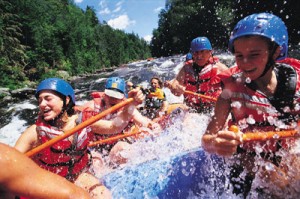While we were at our Wilderness Tours Training Center, we discussed the types of gear and what to wear in the wilderness for water survival.  That night’s talk mainly centered around the argument between natural (cotton, wool, down, etc.) and synthetic (polyester, neoprene, nylon, etc.) fibres. This was a rather heated discussion as we came to consensus that it really was dependant on the situation.
That night’s talk mainly centered around the argument between natural (cotton, wool, down, etc.) and synthetic (polyester, neoprene, nylon, etc.) fibres. This was a rather heated discussion as we came to consensus that it really was dependant on the situation.
Synthetics are good at keeping you dry and warm in wet cases where the fabrics would be subjected to heavy wet conditions where water repulsion and separating the body from water were critical to core body warmth, whereas organics are good at keeping you warm after the wet in retaining body heat and re-building the body’s inner core of warmth. We came to the understanding that if you get organics wet they suck at keeping you warm and they take forever to dry, but applied dry, the benefits of the warmth gained were warmingly insulating. A blend of the two sometimes became the best option where you needed a combination of the benefits of both fibres: other times it comes down to cost factor. Despite the positions on both sides we came to the conclusion that for the rafting and rescue portions of the training, the synthetic fibres offered us the best advantage against the rivers fall edge.
 I purchased my gear from the college and from an awesome gear shop called Mountain Equipment Co-op. Some of the names I purchased when comparison shopping was the Level Six Dry Suit and the Sierra Designs Rash Guard. These have served me well so far. As I learn more I will keep you posted.
I purchased my gear from the college and from an awesome gear shop called Mountain Equipment Co-op. Some of the names I purchased when comparison shopping was the Level Six Dry Suit and the Sierra Designs Rash Guard. These have served me well so far. As I learn more I will keep you posted.
See ya next time folks!
Adventurefrik
Tags: body heat, dry, gear, Level Six, Mountain Equipment Co-op, natural, organics, rafting, rescue, Sierra Designs, survival, synthetic, Wilderness, Wilderness Tours